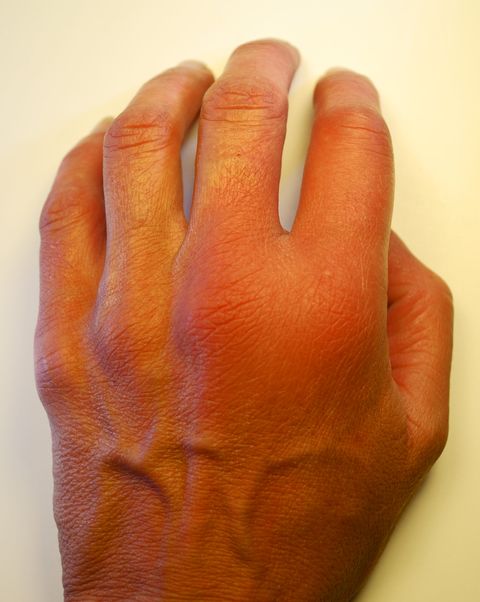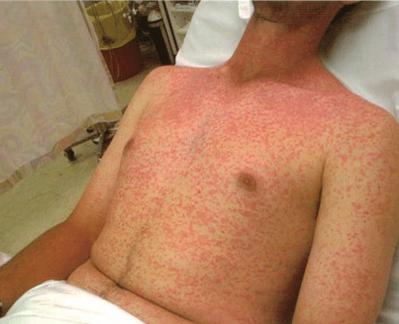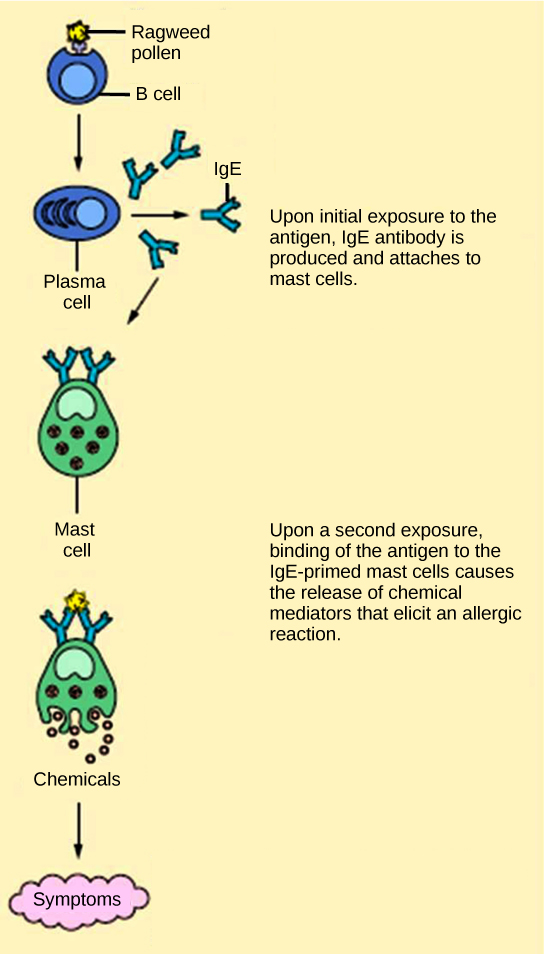Immune System Response
Published .
An allergic response is a hypersensitive immune reaction to a substance that normally is harmless or would not cause an immune response in everyone. An allergic response may cause harmful symptoms such as itching or inflammation or tissue injury.
Allergic reactions Are Localized

Allergic reactions are sensitivities to substances called allergens that come into contact with the skin, nose, eyes, respiratory tract, and gastrointestinal tract. They can be breathed into the lungs, swallowed, or injected.
Considerations
Allergic reactions are common. The immune response that causes an allergic reaction is similar to the response that causes hay fever. Most reactions happen soon after contact with an allergen.
Many allergic reactions are mild, while others can be severe and life threatening. They can be confined to a small area of the body, or they may affect the entire body. The most severe form is called anaphylaxis or anaphylactic shock. Allergic reactions occur more often in people who have a family history of allergies.
Substances that don’t bother most people (such as venom from bee stings and certain foods, medicines, and pollens) can trigger allergic reactions in certain people.
First-time exposure may produce only a mild reaction. Repeated exposures may lead to more serious reactions. Once a person has had an exposure or an allergic reaction (is sensitized), even a very limited exposure to a very small amount of allergen can trigger a severe reaction.
Most severe allergic reactions occur within seconds or minutes after exposure to the allergen. Some reactions can occur after several hours, particularly if the allergen causes a reaction after it has been eaten. In very rare cases, reactions develop after 24 hours.
Anaphylaxis is a sudden and severe allergic reaction that occurs within minutes of exposure. Immediate medical attention is needed for this condition. Without treatment, anaphylaxis can get worse very quickly and lead to death within 15 minutes.
Causes
Common allergens include:
- Animal dander
- Bee stings or stings from other insects
- Foods, especially nuts, fish, and shellfish
- Insect bites
- Medicines
- Plants
- Pollens
Symptoms
Common symptoms of a mild allergic reaction include:
- Hives (especially over the neck and face)
- Itching
- Nasal congestion
- Rashes
- Watery, red eyes
Symptoms of a moderate or severe reaction include:
- Abdominal pain
- Abnormal (high-pitched) breathing sounds
- Anxiety
- Chest discomfort or tightness
- Cough
- Diarrhea
- Difficulty breathing, wheezing
- Difficulty swallowing
- Dizziness or lightheadedness
- Flushing or redness of the face
- Nausea or vomiting
- Palpitations
- Swelling of the face, eyes, or tongue
- Unconsciousness
Anaphylaxis Is Systemic (everywhere)

Anaphylaxis is a life-threatening type of allergic reaction.
Causes
Anaphylaxis is a severe, whole-body allergic reaction to a chemical that has become an allergen. An allergen is a substance that can cause an allergic reaction.
After being exposed to a substance such as bee sting venom, the person’s immune system becomes sensitized to it. When the person is exposed to that allergen again, an allergic reaction may occur. Anaphylaxis happens quickly after the exposure. The condition is severe and involves the whole body.
Tissues in different parts of the body release histamine and other substances. This causes the airways to tighten and leads to other symptoms.
Some drugs (morphine, x-ray dye, aspirin, and others) may cause an anaphylactic-like reaction (anaphylactoid reaction) when people are first exposed to them. These reactions are not the same as the immune system response that occurs with true anaphylaxis. But, the symptoms, risk of complications, and treatment are the same for both types of reactions.
Anaphylaxis can occur in response to any allergen. Common causes include:
- Drug allergies
- Food allergies
- Insect bites/stings
Pollen and other inhaled allergens rarely cause anaphylaxis. Some people have an anaphylactic reaction with no known cause.
Anaphylaxis is life threatening and can occur at any time. Risks include a history of any type of allergic reaction.
Symptoms
Symptoms develop quickly, often within seconds or minutes. They may include any of the following:
- Abdominal pain
- Feeling anxious
- Chest discomfort or tightness
- Diarrhea
- Difficulty breathing, coughing, wheezing, or high-pitched breathing sounds
- Difficulty swallowing
- Dizziness or lightheadedness
- Hives, itchiness, redness of the skin
- Nasal congestion
- Nausea or vomiting
- Palpitations
- Slurred speech
- Swelling of the face, eyes, or tongue
- Unconsciousness
Due to release of histamines and eosinophils the following life threatening symptoms are seen:
- Increased Capillary Permeability – Capillaries are tiny blood vessels that are responsible perfusing the smallest and furthest reaches of the circulatory system. Capillaries make the exchange of carbon dioxide from the cells and provide oxygen. As such, the blood vessels walls have to be so thin that gasses can penetrate it. The histamine and eosinophil release associated with anaphylaxis results make these tiny blood vessels even more permeable (allowing molecules to pass through the blood vessel wall) to the point where the capillaries leak blood into the surrounding tissue. The result is urticaria or hives (rash) and pruritis (itching).
- Vasodilation – Arteries vasodilate or become larger. This has the result of dropping blood pressure.
- Bronchoconstriction – The bronchioles constrict, making it difficult for the patient exhale
- Increased mucous production – The respiratory tract is lined with mucous membranes whose job it is to keep the airways of the body moist. If the mucous membranes didn’t exist, the volume of air passing in and out of the lungs would dry all the structures of the respiratory tract causing them to fail. In anaphylaxis, the mucous production is increased which eventually will make it difficult for the patient to move air as the mucous will obstruct airflow in the bronchioles
Pathophysiology

The immune reaction that results from immediate hypersensitivities in which an antibody-mediated immune response occurs within minutes of exposure to a usually harmless antigen is called an allergy. In the United States, 20 percent of the population exhibits symptoms of allergy or asthma, whereas 55 percent test positive against one or more allergens. On initial exposure to a potential allergen, an allergic individual synthesizes antibodies through the typical process of APCs presenting processed antigen to TH cells that stimulate B cells to produce the antibodies. The antibody molecules interact with mast cells embedded in connective tissues. This process primes, or sensitizes, the tissue. On subsequent exposure to the same allergen, antibody molecules on mast cells bind the antigen and stimulate the mast cell to release histamine and other inflammatory chemicals; these chemical mediators then recruit eosinophils (a type of white blood cell), which also appear to be adapted to responding to parasitic worms. Eosinophils release factors that enhance the inflammatory response and the secretions of mast cells. The effects of an allergic reaction range from mild symptoms like sneezing and itchy, watery eyes to more severe or even life-threatening reactions involving intensely itchy welts or hives, airway constriction with severe respiratory distress, and plummeting blood pressure caused by dilating blood vessels and fluid loss from the circulatory system. This extreme reaction, typically in response to an allergen introduced to the circulatory system, is known as anaphylactic shock. Antihistamines are an insufficient counter to anaphylactic shock and if not treated with epinephrine to counter the blood pressure and breathing effects, this condition can be fatal.
